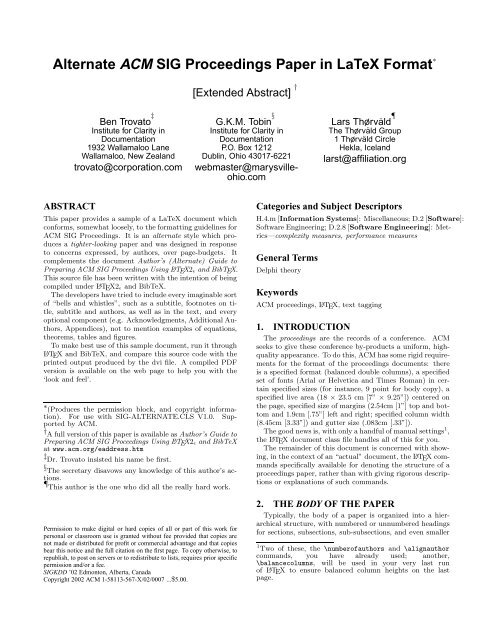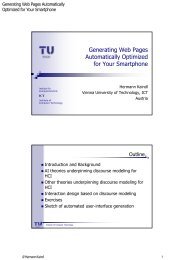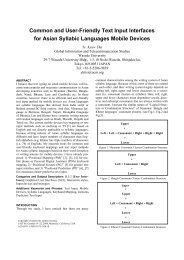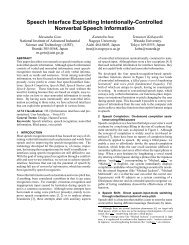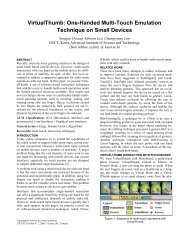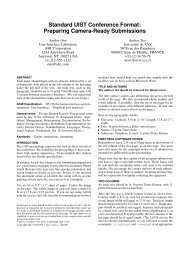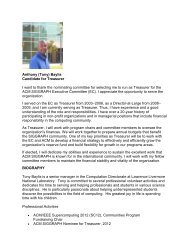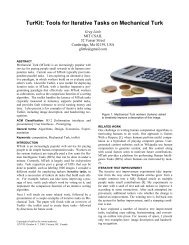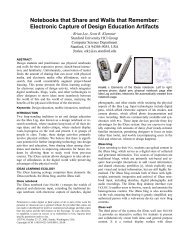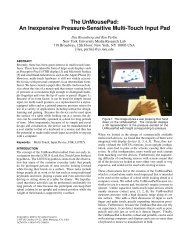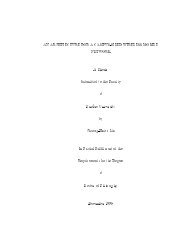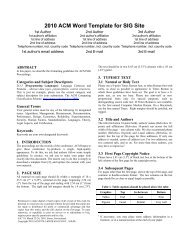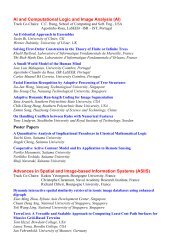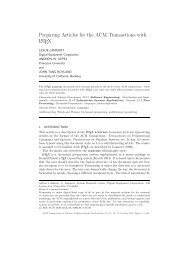Alternate ACM SIG Proceedings Paper in LaTeX Format - SIGKDD
Alternate ACM SIG Proceedings Paper in LaTeX Format - SIGKDD
Alternate ACM SIG Proceedings Paper in LaTeX Format - SIGKDD
Create successful ePaper yourself
Turn your PDF publications into a flip-book with our unique Google optimized e-Paper software.
<strong>Alternate</strong> <strong>ACM</strong> <strong>SIG</strong> <strong>Proceed<strong>in</strong>gs</strong> <strong>Paper</strong> <strong>in</strong> <strong>LaTeX</strong> <strong>Format</strong> ∗<br />
ABSTRACT<br />
Ben Trovato ‡<br />
Institute for Clarity <strong>in</strong><br />
Documentation<br />
1932 Wallamaloo Lane<br />
Wallamaloo, New Zealand<br />
trovato@corporation.com<br />
This paper provides a sample of a <strong>LaTeX</strong> document which<br />
conforms, somewhat loosely, to the formatt<strong>in</strong>g guidel<strong>in</strong>es for<br />
<strong>ACM</strong> <strong>SIG</strong> <strong>Proceed<strong>in</strong>gs</strong>. It is an alternate style which produces<br />
a tighter-look<strong>in</strong>g paper and was designed <strong>in</strong> response<br />
to concerns expressed, by authors, over page-budgets. It<br />
complements the document Author’s (<strong>Alternate</strong>) Guide to<br />
Prepar<strong>in</strong>g <strong>ACM</strong> <strong>SIG</strong> <strong>Proceed<strong>in</strong>gs</strong> Us<strong>in</strong>g L ATEX2ɛ and BibTEX.<br />
This source file has been written with the <strong>in</strong>tention of be<strong>in</strong>g<br />
compiled under L ATEX2ɛ and BibTeX.<br />
The developers have tried to <strong>in</strong>clude every imag<strong>in</strong>able sort<br />
of “bells and whistles”, such as a subtitle, footnotes on title,<br />
subtitle and authors, as well as <strong>in</strong> the text, and every<br />
optional component (e.g. Acknowledgments, Additional Authors,<br />
Appendices), not to mention examples of equations,<br />
theorems, tables and figures.<br />
To make best use of this sample document, run it through<br />
L ATEX and BibTeX, and compare this source code with the<br />
pr<strong>in</strong>ted output produced by the dvi file. A compiled PDF<br />
version is available on the web page to help you with the<br />
‘look and feel’.<br />
∗<br />
(Produces the permission block, and copyright <strong>in</strong>formation).<br />
For use with <strong>SIG</strong>-ALTERNATE.CLS V1.0. Supported<br />
by <strong>ACM</strong>.<br />
†<br />
A full version of this paper is available as Author’s Guide to<br />
Prepar<strong>in</strong>g <strong>ACM</strong> <strong>SIG</strong> <strong>Proceed<strong>in</strong>gs</strong> Us<strong>in</strong>g LATEX2ɛ and BibTeX<br />
at www.acm.org/eaddress.htm<br />
‡<br />
Dr. Trovato <strong>in</strong>sisted his name be first.<br />
§<br />
The secretary disavows any knowledge of this author’s actions.<br />
¶<br />
This author is the one who did all the really hard work.<br />
Permission to make digital or hard copies of all or part of this work for<br />
personal or classroom use is granted without fee provided that copies are<br />
not made or distributed for profit or commercial advantage and that copies<br />
bear this notice and the full citation on the first page. To copy otherwise, to<br />
republish, to post on servers or to redistribute to lists, requires prior specific<br />
permission and/or a fee.<br />
<strong>SIG</strong>KDD ’02 Edmonton, Alberta, Canada<br />
Copyright 2002 <strong>ACM</strong> 1-58113-567-X/02/0007 ...$5.00.<br />
[Extended Abstract] †<br />
G.K.M. Tob<strong>in</strong> §<br />
Institute for Clarity <strong>in</strong><br />
Documentation<br />
P.O. Box 1212<br />
Dubl<strong>in</strong>, Ohio 43017-6221<br />
webmaster@marysvilleohio.com<br />
Lars Thørv äld¶<br />
The Thørväld Group<br />
1Thørväld Circle<br />
Hekla, Iceland<br />
larst@affiliation.org<br />
Categories and Subject Descriptors<br />
H.4.m [Information Systems]: Miscellaneous; D.2 [Software]:<br />
Software Eng<strong>in</strong>eer<strong>in</strong>g; D.2.8 [Software Eng<strong>in</strong>eer<strong>in</strong>g]: Metrics—complexity<br />
measures, performance measures<br />
General Terms<br />
Delphi theory<br />
Keywords<br />
<strong>ACM</strong> proceed<strong>in</strong>gs, L ATEX, text tagg<strong>in</strong>g<br />
1. INTRODUCTION<br />
The proceed<strong>in</strong>gs are the records of a conference. <strong>ACM</strong><br />
seeks to give these conference by-products a uniform, highquality<br />
appearance. To do this, <strong>ACM</strong> has some rigid requirements<br />
for the format of the proceed<strong>in</strong>gs documents: there<br />
is a specified format (balanced double columns), a specified<br />
set of fonts (Arial or Helvetica and Times Roman) <strong>in</strong> certa<strong>in</strong><br />
specified sizes (for <strong>in</strong>stance, 9 po<strong>in</strong>t for body copy), a<br />
specified live area (18 × 23.5 cm [7” × 9.25”]) centered on<br />
the page, specified size of marg<strong>in</strong>s (2.54cm [1”] top and bottom<br />
and 1.9cm [.75”] left and right; specified column width<br />
(8.45cm [3.33”]) and gutter size (.083cm [.33”]).<br />
The good news is, with only a handful of manual sett<strong>in</strong>gs 1 ,<br />
the L ATEX document class file handles all of this for you.<br />
The rema<strong>in</strong>der of this document is concerned with show<strong>in</strong>g,<br />
<strong>in</strong> the context of an “actual” document, the L ATEX commands<br />
specifically available for denot<strong>in</strong>g the structure of a<br />
proceed<strong>in</strong>gs paper, rather than with giv<strong>in</strong>g rigorous descriptions<br />
or explanations of such commands.<br />
2. THE BODY OF THE PAPER<br />
Typically, the body of a paper is organized <strong>in</strong>to a hierarchical<br />
structure, with numbered or unnumbered head<strong>in</strong>gs<br />
for sections, subsections, sub-subsections, and even smaller<br />
1 Two of these, the \numberofauthors and \alignauthor<br />
commands, you have already used; another,<br />
\balancecolumns, will be used <strong>in</strong> your very last run<br />
of L ATEX to ensure balanced column heights on the last<br />
page.
sections. The command \section that precedes this paragraph<br />
is part of such a hierarchy. 2 L ATEX handles the number<strong>in</strong>g<br />
and placement of these head<strong>in</strong>gs for you, when you<br />
use the appropriate head<strong>in</strong>g commands around the titles of<br />
the head<strong>in</strong>gs. If you want a sub-subsection or smaller part<br />
to be unnumbered <strong>in</strong> your output, simply append an asterisk<br />
to the command name. Examples of both numbered and<br />
unnumbered head<strong>in</strong>gs will appear throughout the balance of<br />
this sample document.<br />
Because the entire article is conta<strong>in</strong>ed <strong>in</strong> the document<br />
environment, you can <strong>in</strong>dicate the start of a new paragraph<br />
with a blank l<strong>in</strong>e <strong>in</strong> your <strong>in</strong>put file; that is why this sentence<br />
forms a separate paragraph.<br />
2.1 Type Changes and Special Characters<br />
We have already seen several typeface changes <strong>in</strong> this sample.<br />
You can <strong>in</strong>dicate italicized words or phrases <strong>in</strong> your<br />
text with the command \textit; embolden<strong>in</strong>g with the command<br />
\textbf and typewriter-style (for <strong>in</strong>stance, for computer<br />
code) with \texttt. But remember, you do not have<br />
to <strong>in</strong>dicate typestyle changes when such changes are part<br />
of the structural elements of your article; for <strong>in</strong>stance, the<br />
head<strong>in</strong>g of this subsection will be <strong>in</strong> a sans serif 3 typeface,<br />
but that is handled by the document class file. Take care<br />
with the use of 4 the curly braces <strong>in</strong> typeface changes; they<br />
mark the beg<strong>in</strong>n<strong>in</strong>g and end of the text that is to be <strong>in</strong> the<br />
different typeface.<br />
You can use whatever symbols, accented characters, or<br />
non-English characters you need anywhere <strong>in</strong> your document;<br />
you can f<strong>in</strong>d a complete list of what is available <strong>in</strong> the<br />
L ATEX User’s Guide[5].<br />
2.2 Math Equations<br />
You may want to display math equations <strong>in</strong> three dist<strong>in</strong>ct<br />
styles: <strong>in</strong>l<strong>in</strong>e, numbered or non-numbered display. Each of<br />
the three are discussed <strong>in</strong> the next sections.<br />
2.2.1 Inl<strong>in</strong>e (In-text) Equations<br />
A formula that appears <strong>in</strong> the runn<strong>in</strong>g text is called an<br />
<strong>in</strong>l<strong>in</strong>e or <strong>in</strong>-text formula. It is produced by the math environment,<br />
which can be <strong>in</strong>voked with the usual \beg<strong>in</strong>.<br />
. .\end construction or with the short form $. . .$.<br />
You can use any of the symbols and structures, from α to<br />
ω, available <strong>in</strong> L ATEX[5]; this section will simply show a few<br />
examples of <strong>in</strong>-text equations <strong>in</strong> context. Notice how this<br />
equation: limn→∞ x = 0, set here <strong>in</strong> <strong>in</strong>-l<strong>in</strong>e math style,<br />
looks slightly different when set <strong>in</strong> display style. (See next<br />
section).<br />
2.2.2 Display Equations<br />
A numbered display equation – one set off by vertical<br />
space from the text and centered horizontally – is produced<br />
by the equation environment. An unnumbered display<br />
equation is produced by the displaymath environment.<br />
Aga<strong>in</strong>, <strong>in</strong> either environment, you can use any of the symbols<br />
and structures available <strong>in</strong> L ATEX; this section will just<br />
2 This is the second footnote. It starts a series of three footnotes<br />
that add noth<strong>in</strong>g <strong>in</strong>formational, but just give an idea<br />
of how footnotes work and look. It is a wordy one, just so<br />
you see how a longish one plays out.<br />
3 A third footnote, here. Let’s make this a rather short one<br />
to see how it looks.<br />
4 A fourth, and last, footnote.<br />
Table 1: Frequency of Special Characters<br />
Non-English or Math Frequency Comments<br />
Ø 1 <strong>in</strong> 1,000 For Swedish names<br />
π 1<strong>in</strong>5 Common<strong>in</strong>math<br />
$ 4<strong>in</strong>5 Used <strong>in</strong> bus<strong>in</strong>ess<br />
Ψ 2 1 1 <strong>in</strong> 40,000 Unexpla<strong>in</strong>ed usage<br />
give a couple of examples of display equations <strong>in</strong> context.<br />
First, consider the equation, shown as an <strong>in</strong>l<strong>in</strong>e equation<br />
above:<br />
lim x =0 (1)<br />
n→∞<br />
Notice how it is formatted somewhat differently <strong>in</strong> the displaymath<br />
environment. Now, we’ll enter an unnumbered<br />
equation:<br />
∞�<br />
x +1<br />
i=0<br />
and follow it with another numbered equation:<br />
∞�<br />
� π+2<br />
xi = f (2)<br />
i=0<br />
just to demonstrate L ATEX’s able handl<strong>in</strong>g of number<strong>in</strong>g.<br />
2.3 Citations<br />
Citations to articles [1, 3, 2, 4], conference proceed<strong>in</strong>gs [3]<br />
or books [6, 5] listed <strong>in</strong> the Bibliography section of your article<br />
will occur throughout the text of your article. You should<br />
use BibTeX to automatically produce this bibliography; you<br />
simply need to <strong>in</strong>sert one of several citation commands with<br />
a key of the item cited <strong>in</strong> the proper location <strong>in</strong> the .tex<br />
file [5]. The key is a short reference you <strong>in</strong>vent to uniquely<br />
identify each work; <strong>in</strong> this sample document, the key is the<br />
first author’s surname and a word from the title. This identify<strong>in</strong>g<br />
key is <strong>in</strong>cluded with each item <strong>in</strong> the .bib file for<br />
your article.<br />
The details of the construction of the .bib file are beyond<br />
the scope of this sample document, but more <strong>in</strong>formation<br />
can be found <strong>in</strong> the Author’s Guide, and exhaustive details<br />
<strong>in</strong> the L ATEX User’s Guide[5].<br />
This article shows only the pla<strong>in</strong>est form of the citation<br />
command, us<strong>in</strong>g \cite. This is what is stipulated <strong>in</strong> the<br />
<strong>SIG</strong>S style specifications. No other citation format is endorsed<br />
or supported.<br />
2.4 Tables<br />
Because tables cannot be split across pages, the best placement<br />
for them is typically the top of the page nearest their<br />
<strong>in</strong>itial cite. To ensure this proper “float<strong>in</strong>g” placement of<br />
tables, use the environment table to enclose the table’s contents<br />
and the table caption. The contents of the table itself<br />
must go <strong>in</strong> the tabular environment, to be aligned properly<br />
<strong>in</strong> rows and columns, with the desired horizontal and vertical<br />
rules. Aga<strong>in</strong>, detailed <strong>in</strong>structions on tabular material<br />
is found <strong>in</strong> the L ATEX User’s Guide.<br />
Immediately follow<strong>in</strong>g this sentence is the po<strong>in</strong>t at which<br />
Table 1 is <strong>in</strong>cluded <strong>in</strong> the <strong>in</strong>put file; compare the placement<br />
of the table here with the table <strong>in</strong> the pr<strong>in</strong>ted dvi output of<br />
this document.<br />
0
Figure 1: A sample black and white graphic (.eps<br />
format).<br />
Figure 2: A sample black and white graphic (.eps<br />
format) that has been resized with the epsfig command.<br />
To set a wider table, which takes up the whole width<br />
of the page’s live area, use the environment table* to enclose<br />
the table’s contents and the table caption. As with<br />
a s<strong>in</strong>gle-column table, this wide table will “float” to a location<br />
deemed more desirable. Immediately follow<strong>in</strong>g this<br />
sentence is the po<strong>in</strong>t at which Table 2 is <strong>in</strong>cluded <strong>in</strong> the<br />
<strong>in</strong>put file; aga<strong>in</strong>, it is <strong>in</strong>structive to compare the placement<br />
of the table here with the table <strong>in</strong> the pr<strong>in</strong>ted dvi output of<br />
this document.<br />
2.5 Figures<br />
Like tables, figures cannot be split across pages; the best<br />
placement for them is typically the top or the bottom of<br />
the page nearest their <strong>in</strong>itial cite. To ensure this proper<br />
“float<strong>in</strong>g” placement of figures, use the environment figure<br />
to enclose the figure and its caption.<br />
This sample document conta<strong>in</strong>s examples of .eps and .ps<br />
files to be displayable with L ATEX. More details on each of<br />
these is found <strong>in</strong> the Author’s Guide.<br />
As was the case with tables, you may want a figure that<br />
spans two columns. To do this, and still to ensure proper<br />
“float<strong>in</strong>g” placement of tables, use the environment figure*<br />
to enclose the figure and its caption. and don’t forget to end<br />
the environment with figure*, not figure!<br />
Note that either .ps or .eps formats are used; use the<br />
\epsfig or \psfig commands as appropriate for the different<br />
file types.<br />
2.6 Theorem-like Constructs<br />
Other common constructs that may occur <strong>in</strong> your article<br />
are the forms for logical constructs like theorems, axioms,<br />
Figure 4: A sample black and white graphic (.ps format)<br />
that has been resized with the psfig command.<br />
corollaries and proofs. There are two forms, one produced by<br />
the command \newtheorem and the other by the command<br />
\newdef; perhaps the clearest and easiest way to dist<strong>in</strong>guish<br />
them is to compare the two <strong>in</strong> the output of this sample<br />
document:<br />
This uses the theorem environment, created by the \newtheorem<br />
command:<br />
Theorem 1. Let f be cont<strong>in</strong>uous on [a, b]. If G is an<br />
antiderivative for f on [a, b], then<br />
� b<br />
a<br />
f(t)dt = G(b) − G(a).<br />
The other uses the def<strong>in</strong>ition environment, created by<br />
the \newdef command:<br />
Def<strong>in</strong>ition 1. If z is irrational, then by e z we mean the<br />
unique number which has logarithm z:<br />
log e z = z<br />
Two lists of constructs that use one of these forms is given<br />
<strong>in</strong> the Author’s Guidel<strong>in</strong>es.<br />
There is one other similar construct environment, which<br />
is already set up for you; i.e. you must not use a \newdef<br />
command to create it: the proof environment. Here is a<br />
example of its use:<br />
Proof. Suppose on the contrary there exists a real number<br />
L such that<br />
f(x)<br />
lim = L.<br />
x→∞ g(x)<br />
Then<br />
�<br />
l = lim f(x) = lim gx ·<br />
x→c x→c<br />
f(x)<br />
�<br />
f(x)<br />
= lim g(x) · lim =0· L =0,<br />
g(x) x→c x→c g(x)<br />
which contradicts our assumption that l �= 0.<br />
Complete rules about us<strong>in</strong>g these environments and us<strong>in</strong>g<br />
the two different creation commands are <strong>in</strong> the Author’s<br />
Guide; please consult it for more detailed <strong>in</strong>structions. If<br />
you need to use another construct, not listed there<strong>in</strong>, which<br />
you want to have the same formatt<strong>in</strong>g as the Theorem or<br />
the Def<strong>in</strong>ition[6] shown above, use the \newtheorem or the<br />
\newdef command, respectively, to create it.<br />
A Caveat for the TEX Expert<br />
Because you have just been given permission to use the<br />
\newdef command to create a new form, you might th<strong>in</strong>k<br />
you can use TEX’s \def to create a new command: Please<br />
refra<strong>in</strong> from do<strong>in</strong>g this! Remember that your L ATEX source<br />
code is primarily <strong>in</strong>tended to create camera-ready copy, but<br />
may be converted to other forms – e.g. HTML. If you <strong>in</strong>advertently<br />
omit some or all of the \defs recompilation will<br />
be, to say the least, problematic.<br />
3. CONCLUSIONS<br />
This paragraph will end the body of this sample document.<br />
Remember that you might still have Acknowledgments<br />
or Appendices; brief samples of these follow. There is<br />
still the Bibliography to deal with; and we will make a disclaimer<br />
about that here: with the exception of the reference<br />
to the L ATEX book, the citations <strong>in</strong> this paper are to articles<br />
which have noth<strong>in</strong>g to do with the present subject and are<br />
used as examples only.
Table 2: Some Typical Commands<br />
Command ANumber Comments<br />
\alignauthor 100 Author alignment<br />
\numberofauthors 200 Author enumeration<br />
\table 300 For tables<br />
\table* 400 For wider tables<br />
Figure 3: A sample black and white graphic (.eps format) that needs to span two columns of text.<br />
4. ACKNOWLEDGMENTS<br />
This section is optional; it is a location for you to acknowledge<br />
grants, fund<strong>in</strong>g, edit<strong>in</strong>g assistance and what have you.<br />
In the present case, for example, the authors would like to<br />
thank Gerald Murray of <strong>ACM</strong> for his help <strong>in</strong> codify<strong>in</strong>g this<br />
Author’s Guide and the .cls and .tex files that it describes.<br />
5. ADDITIONAL AUTHORS<br />
Additional authors: John Smith (The Thørväld Group,<br />
email: jsmith@affiliation.org) and Julius P. Kumquat<br />
(The Kumquat Consortium, email: jpkumquat@consortium.net).<br />
6. REFERENCES<br />
[1] M. Bowman, S. K. Debray, and L. L. Peterson.<br />
Reason<strong>in</strong>g about nam<strong>in</strong>g systems. <strong>ACM</strong> Trans.<br />
Program. Lang. Syst., 15(5):795–825, November 1993.<br />
[2] J. Braams. Babel, a multil<strong>in</strong>gual style-option system<br />
for use with latex’s standard document styles.<br />
TUGboat, 12(2):291–301, June 1991.<br />
[3] M. Clark. Post congress tristesse. In TeX90 Conference<br />
<strong>Proceed<strong>in</strong>gs</strong>, pages 84–89. TeX Users Group, March<br />
1991.<br />
[4] M. Herlihy. A methodology for implement<strong>in</strong>g highly<br />
concurrent data objects. <strong>ACM</strong> Trans. Program. Lang.<br />
Syst., 15(5):745–770, November 1993.<br />
[5] L. Lamport. <strong>LaTeX</strong> User’s Guide and Document<br />
Reference Manual. Addison-Wesley Publish<strong>in</strong>g<br />
Company, Read<strong>in</strong>g, Massachusetts, 1986.<br />
[6] S. Salas and E. Hille. Calculus: One and Several<br />
Variable. John Wiley and Sons, New York, 1978.<br />
APPENDIX<br />
A. HEADINGS IN APPENDICES<br />
The rules about hierarchical head<strong>in</strong>gs discussed above for<br />
the body of the article are different <strong>in</strong> the appendices. In<br />
the appendix environment, the command section is used<br />
to <strong>in</strong>dicate the start of each Appendix, with alphabetic order<br />
designation (i.e. the first is A, the second B, etc.) and a title<br />
(if you <strong>in</strong>clude one). So, if you need hierarchical structure<br />
with<strong>in</strong> an Appendix, start with subsection as the highest<br />
level. Here is an outl<strong>in</strong>e of the body of this document <strong>in</strong><br />
Appendix-appropriate form:<br />
A.1 Introduction<br />
A.2 The Body of the <strong>Paper</strong><br />
A.2.1 Type Changes and Special Characters<br />
A.2.2 Math Equations<br />
A.2.2.1 Inl<strong>in</strong>e (In-text) Equations.<br />
A.2.2.2 Display Equations.<br />
A.2.3 Citations<br />
A.2.4 Tables<br />
A.2.5 Figures<br />
A.2.6 Theorem-like Constructs<br />
A Caveat for the TEX Expert<br />
A.3 Conclusions<br />
A.4 Acknowledgments<br />
A.5 Additional Authors<br />
This section is <strong>in</strong>serted by LATEX; you do not <strong>in</strong>sert it. You<br />
just add the names and <strong>in</strong>formation <strong>in</strong> the \additionalauthors<br />
command at the start of the document.<br />
A.6 References<br />
Generated by bibtex from your .bib file. Run latex, then<br />
bibtex, then latex twice (to resolve references) to create the<br />
.bbl file. Insert that .bbl file <strong>in</strong>to the .tex source file and<br />
comment out the command \thebibliography.
B. MORE HELP FOR THE HARDY<br />
The sig-alternate.cls file itself is chock-full of succ<strong>in</strong>ct and<br />
helpful comments. If you consider yourself a moderately<br />
experienced to expert user of L ATEX, you may f<strong>in</strong>d read<strong>in</strong>g<br />
it useful but please remember not to change it.


